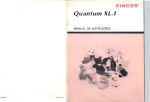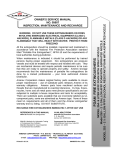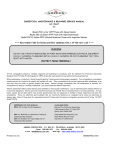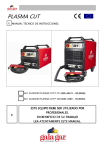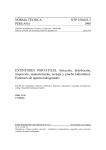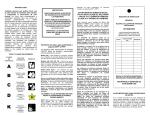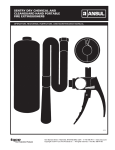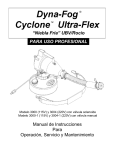Download Class A Class B Class C Class K
Transcript
the indicator may read on the low side of the “charged” zone and if the temperature is hot it may read on the high side of the “charged” zone. The true reading of the pressure may be verified by placing the extinguisher at room temperature (70° F) for 24 hours. If any anomalies are found during the inspection please notify your local Shield Distributor for a thorough inspection and resolution. SHIELD FIRE PROTECTION PO BOX 428, Kings Mountain, NC. 28086-0428 E-mail: [email protected] www.shieldprotects.com AN INSPECTION TAG IS INCORPORATED INTO THIS OWNER’S MANUAL. PLEASE DETACH IT, HANG IT ON THE EXTINGUISHER, AND RECORD YOUR MONTHLY INSPECTIONS. CAUTION DO NOT INCINERATE. The charged extinguisher is pressurized and may explode. KEEP EXTINGUISHER OUT OF THE REACH OF SMALL CHILDREN. INSTALLATION Hang your extinguisher in a clean, dry, and easily accessible location near an exit. The top of the extinguisher should be positioned not less than 3 1/2 feet or more than 5 feet from the floor. Do not install the extinguisher where you would have to walk through a possible fire to reach it. Do not install the extinguisher in areas subject to extreme hot or cold temperatures (refer to the extinguisher nameplate for the exact temperatures the extinguisher can withstand.) OWNER’S MANUAL AND WARRANTY FOR YOUR HAND PORTABLE FIRE EXTINGUISHER INTRODUCTION This fire extinguisher has been manufactured by Shield Fire Protection Company to industrial application specifications. It has been designed with ease of use, effective fire fighting capabilities, and long service life as the paramount standards. Dedicated quality control and modern manufacturing facilities provide you with the best fire extinguisher value in the fire protection industry. Shield’s quality of workmanship is exhibited in its guarantee to repair or replace any extinguisher that exhibits any defect in workmanship or material during the length of the warranty period. INSPECTION This extinguisher should be inspected monthly for any possible damage, corrosion, leakage, or obstructions in the discharge outlet. Check the tamper seal to be sure that it is intact. Check for any dents or damage to the extinguisher body and discharge valve assembly. Clean the extinguisher so that the instructions on the nameplate are clearly visible. Weigh the extinguisher to verify the full weight is within the tolerance indicated on the nameplate. For extinguishers with pressure gauges, check the needle indicator. It should be in the green area and pointing straight up. NOTE: Changes in temperature may cause the indicator on the pressure gauge to vary within the Green area on stored pressure type extinguishers. The Green area is the “charged” zone. When the temperature is cold MOUNTING INSTRUCTIONS In accordance with UL requirements, a fire extinguisher mounting device must withstand a critical load of five times the weight of a charged unit but not less that 100 pounds. Extinguisher hangers should be mounted as follows: WALLS (Wood studded) - On 2 1/2 lb. Extinguishers mount the hanger using two #8x1 in. long wood screws diagonally from each other directly into the stud. On all other hangers use one #14x 1 1/4 in. long wood screw directly centered in the stud. SHEET ROCK OR PLASTER - For all size hangers, mount a 3/4 in. thick board to the wall using 3/16in. toggle bolts. The board size should extend a minimum of two inches beyond the profile of the extinguisher (excluding the hose and/or nozzle). Mount the hanger to the board using screws as noted above under “WALLS”. CINDER BLOCK OR MASONRY- On 2 1/2 lb. size units, mount the hanger using one 3/16 in. toggle bolt or masonry lead expansion anchor through one of the hanger’s top holes. On all other size units use 1/4 in. toggle bolts or #14 lead screw anchors. CONCRETE OR TILE WALLS - on 2 1/2 lb. size units, mount the hanger using one #10 masonry lead screw expansion anchor through one of the top holes. On all other hangers use a #14 masonry lead screw expansion anchor through the center hole in the hanger. For Tile Locate the attachment hole in a joint. STEEL POSTS OR BEAMS-Drill hole(s) (two for 2 1/2lb. hanger, one for all others) and either tap the attachment holes or use bolts and nuts for fastening. IMPORTANT NOTICE TO BOAT OWNERS For “Marine type” extinguishers, the U.S.C.G. approval is valid only when a Coast Guard approved extinguisher is equipped with the approved marine type bracket that is specified on the extinguisher nameplate. INSPECTION RECORD Model No.______________________________________ Serial No.______________________________________ Date Installed New:______________________________ INSPECTION should be performed monthly or more frequently if circumstances warrant. The extinguisher should be checked to verify that it is not damaged, that the discharge outlet is not obstructed in any manner, that the tamper seal is intact, and that the operating instructions are clearly visible and legible. ANNUAL INSPECTION is a more comprehensive inspection of the extinguisher and should be done by a trained professional. It will determine the need for hydrostatic testing of the unit. Hydrostatic testing is required every five years on Wet Chemical, Water, Water Mist, and Carbon Dioxide extinguishers. Dry Chemical and Halotron extinguishers are hydrotested every twelve years. Contact your local authorities about requirements for attaching special tags to the extinguisher as verification of this service. SIX YEAR MAINTENANCE SERVICE is required for extinguishers that are on the twelve-year hydro test cycle. Every six years the extinguisher shall be emptied and undergo a thorough examination of its mechanical parts, extinguishing agent, and its means of expulsion. Note: Removal of the agent in Halotron extinguishers shall only be done with a UL approved closed recovery system. When the applicable maintenance procedures are done during periodic recharging or hydro testing, the six-year requirement will begin from that date. RECHARGE of the extinguisher should be done by trained personnel at your local Shield Distributor immediately after any use. The Distributor has the extinguishing agent and the equipment necessary to perform the recharge properly. The extinguisher must be recharged with the extinguishing agent specified on the nameplate. Substitution could cause damage or injury. CAUTION ABC Dry Chemical extinguishers are not recommended for use in swimming pool chemical storage areas. Also, they should not be installed in kitchens where they might be used on cooking grease fires. Wet Chemical is the extinguishing agent recommended for this type of fire. USE OF DRY OR WET CHEMICAL AGENT EXTINGUISHERS ON FIRES INVOLVING DELICATE ELECTRONIC EQUIPMENT IS NOT RECOMMENDED. THEY MAY SUCCESSFULLY EXTINGUISH THE FIRE BUT THEY MAY ALSO DAMAGE THE EQUIPMENT BEYOND REPAIR. WARRANTY Shield Fire Protection promises to the original Consumer Purchaser to repair or replace, at the option of Shield, at no cost to the Consumer Purchaser, any part of this fire extinguisher which proves to be defective in workmanship or material under normal use, in the USA or Canada for a period of six years from the date of purchase, except Halotron 1 which has a one year warranty. During such time, Shield will provide all parts necessary to correct such defects free of charge, provided that the product has been operated in accordance with the instructions on the nameplate or elsewhere. The original Consumer Purchaser shall give notice of any such defects by writing to Shield Fire Protection., PO BOX 428, Kings Mountain, NC 280860428. THIS WARRANTY SHALL NOT APPLY IF THE EXTINGUISHER IS DAMAGED WHILE IN THE POSSESSION OF THE PURCHASER, WHETHER DUE TO AN ACCIDENT, ACT OF GOD, OR OTHERWISE, OR SUBJECTED TO UNREASONABLE USE WHICH CAUSES IT TO MALFUNCTION OR BECOME DEFECTIVE. THE TERM “UNREASONABLE USE” SHALL INCLUDE FAILURE TO PROVIDE REASONABLE AND NECESSARY MAINTENANCE IN ACCORDANCE WITH THE INSTRUCTIONS ON THE NAMEPLATE OR ELSEWHERE. SHIELD ASSUMES NO LIABILITY FOR CONSEQUENTIAL OR INCIDENTAL DAMAGES. SOME STATES DO NOT ALLOW THE EXCLUSION OR LIMITATION OF INCIDENTAL DAMAGES, SO THE ABOVE LIMITATION OR EXCLUSION MAY NOT APPLY TO YOU. This warranty gives you specific legal rights and you may have other rights which vary from state to state. IMPORTANT Water fire extinguishers are shipped uncharged (empty) and non pressurized from the factory. Carbon Dioxide, Halotron 1, Dry Chemical, Water Mist, and Wet Chemical extinguishers are shipped fully charged from the factory. Do not experiment with your extinguisher. Even a small amount of discharge could cause a slow loss of the rest of its pressure, rendering the extinguisher useless. IN CASE OF FIRE Have everyone vacate the area immediately. Call the Fire Department no matter what the size of fire. Emergency phone numbers should be posted at each phone. Use your extinguisher correctly, in accordance with the directions on the nameplate and in this manual. Large fires should be handled by professionals. Be ready to leave the area in the event that the fire cannot be controlled immediately. PROPER USAGE NOTE: The following instructions are of a general nature and are intended to familiarize the user with the key functions of Shield hand portable fire extinguishers. Read the extinguisher nameplate for specific techniques and starting distances for effective fire fighting. • HOLD THE EXTINGUISHER UPRIGHT. • PULL THE RING PIN. • START BACK FROM THE FIRE THE MINIMUM DISTANCE INDICATED ON THE NAMEPLATE. • AIM AT THE BASE OF THE FIRE. • WHILE CONTINUING TO KEEP THE EXTINGUISHER UPRIGHT, SQUEEZE THE HANDLES TOGETHER TO DISCHARGE THE EXTINGUISHING AGENT. • SWEEP THE EXTINGUISHER FROM SIDE TO SIDE WHILE MOVING CLOSER TO THE FIRE AREA AS THE FIRE IS EXTINGUISHED (BUT NOT SO CLOSE AS TO DISPERSE THE BURNING MATERIAL). BE DANGEROUS AND THEY CAN BE DEADLY. TYPES AND CLASSES OF FIRES The label on the extinguisher shows the class of fire the extinguisher is listed for at Underwriters Laboratory. Class A Fires involving wood, paper, cloth, trash & other common combustibles. Class B Class C Fires involving live electrical equipment. Class K Fires involving cooking grease and oils. Upon request Material Safety Data Sheets (MSDS) are available for all Shield Fire Protection fire extinguishers and can be downloaded from www.shieldprotects.com. WET CHEMICAL EXTINGUISHERS MUST BE DISCHARGED ON KITCHEN GREASE FIRES UNTIL EMPTY TO PERMIT ADDITIONAL COOLING AND RETARDATION OF FLASH BACK. WHEN THE FIRE IS EXTINGUISHED, BEWARE OF REIGNITION. VACATE AND VENTILATE THE AREA IMMEDIATELY AFTER USE. FUMES AND SMOKE FROM ANY FIRE MAY Manual Part Number 900545 MANUAL DEL USUARIO Y GARANTÍA DEL EXTINTOR DE INCENDIOS MANUAL PORTÁTIL IMPORTANTE REGISTRO DE INSPECCIONES Asegurar al extintor antes de la instalación. Favor no remover. Seguir las instrucciones de la inspección que se encuentran en este manual y en el extintor. FECHA INSPECCIONADO POR INTRODUCCIÓN Este extintor de incendios ha sido fabricado por Shield Fire Protection Company cumpliendo con las especificaciones para aplicación industrial. Se ha diseñado para facilitar su uso, con efectiva capacidad para combatir incendios, y una vida útil larga como normas de primer orden. El exclusivo control de calidad y las instalaciones de fabricación modernas le proporcionan a usted el mejor valor en extintor de incendios de la industria de la protección contra incendios. La calidad del trabajo de Shield lo demuestra su garantía para reparar o reemplazar cualquier extintor que resulte defectuoso en la fabricación o el material, durante todo el período de garantía. INSPECCIÓN Este extintor debe ser inspeccionado mensualmente para detectar cualquier posible daño, corrosión, filtración u obstrucciones en el orificio de salida. Cerciórese de que el sello a prueba de manipulación para asegurarse que se encuentre intacto. Revise si hay abolladuras o daños en la superficie y en la válvula de descarga del extintor. Limpie el extintor para que las instrucciones de la placa estén claramente visibles. Pese el extintor para comprobar que el peso completo se encuentre dentro del rango aceptable que se indica en la placa. En el caso de extintores que cuentan con manómetros, revise la aguja indicadora. Debería encontrarse en el área verde y señalando hacia arriba. NOTA: Los cambios de temperatura pueden hacer que el indicador del manómetro varé dentro del área verde en los extintores de presión que se encuentran almacenados. El área verde es la zona que indica que el extintor está “cargado”. Cuando la temperatura está fría, el indicador puede verse en la parte baja de la zona que indica “cargado” y si la temperatura está caliente puede leerse en la parte alta de la zona que indica “cargado”. La lectura real de la presión puede verificarse colocando el extintor a temperatura de ambiente (70º F) durante 24 horas. Si se encuentran anomalías durante la inspección por favor notifíqueselo a su Distribuidor Shield local para que haga una inspección completa y resuelva el problema. Hacerle mantenimiento profesional al extintor y recargarlo inmediatamente después de cada uso. ESTE MANUAL DEL USUARIO TIENE INCORPORADA UNA ETIQUETA DE INSPECCIÓN. FAVOR RETIRARLA, COLGARLA EN EL EXTINTOR Y REGISTRE LAS INSPECCIONES MENSUALES. PRECAUCIÓN NO INCINERAR. El extintor cargado está presurizado y podría explotar. MANTENGA EL EXTINTOR FUERA DEL ALCANCE DE NIÑOS PEQUEÑOS. INSTALACIÓN Cuelgue el extintor en un lugar limpio, seco y de fácil acceso cerca a una salida. La parte superior del extintor debe ser colocada a no menos de 3 ½ pies ni más de 5 pies del piso. No instale el extintor en un lugar donde usted tuviese que pasar a través del fuego para alcanzarlo. No instale el extintor en áreas que están sujetas a temperaturas de calor o frío extremos (revise la placa del extintor para conocer cuales son las temperaturas exactas que resiste el extintor). INSTRUCCIONES PARA EL MONTAJE Según los requisitos de UL, un dispositivo para el montaje de un extintor de incendios debe soportar una carga de por lo menos cinco veces el peso de una unidad cargada, pero no menos de 100 libras. Los ganchos para colgar extintores deben montarse de la siguiente manera: PAREDES (con taco de madera)- En el caso de extintores de 2 ½ lbs., montar el gancho usando dos tornillos para madera #8x1 pulgadas de largo directamente en el taco de madera en forma diagonal el uno del otro. En todos los demás ganchos utilice un tornillo de madera #14 x 1 pulgadas de largo, directamente en el taco de madera y centrado. LÁMINA ROCA O YESO - Para ganchos de todos los tamaños, monte una tabla de ¾ de pulgada en la pared utilizando tornillos de fiador en T de 3/16 pulgadas. El tamaño de la tabla debe extenderse mínimo dos pulgadas más allá del perfil de extintor (excluyendo la manguera y/o la boquilla). Montar el gancho en la tabla usando tornillos tal como se anotó anteriormente para “PAREDES”. BLOQUE DE HORMIGÓN LIGERO O CONSTRUCCIÓN DE ALBAÑILERÍA - Para las unidades de 2 lbs., monte el gancho usando un tornillo de fiador en T de 3/16 pulgadas o un anclaje de expansión de plomo para albañilería a través de uno de los huecos superiores del gancho. Para todas las demás unidades, usar tornillos de fiador en T de ¼ de pulgada o anclaje de tornillo de plomo #14. POSTES DE ACERO O VIGAS - Perforar hueco(s) (para el gancho de 2 ½ lbs., uno para los demás) y luego usar tuercas y tornillos para asegurarlo. AVISO IMPORTANTE PARA LOS DUEÑOS DE EMBARCACIONES. Para los extintores de “Tipo Marino” la aprobación de la Guardia Costera de los Estados Unidos solo es válida cuando un extintor aprobado por la Guardia Costera está equipado con el soporte de tipo marino, aprobado que se especifica en la placa del extintor. REGISTRO DE INSPECCIÓN Modelo No.______________________________________ Serial No. ______________________________________ Fecha en que se instaló por primera vez_______________ INSPECCIÓN - Debe hacerse mensualmente o con mayor frecuencia si las circunstancias lo ameritan. El extintor debe revisarse para verificar que no esté dañado, que el orificio de descarga no esté obstruido de ninguna manera, que el sello a prueba de manipulación se encuentre intacto y que las instrucciones para la operación se encuentren claramente visibles y legibles. INSPECCIÓN ANUAL – Se trata de una inspección más completa del extintor y debe ser practicada por un profesional capacitado. Se determinará la necesidad de hacerle una prueba hidrostática a la unidad. La prueba hidrostática se requiere cada cinco años en el caso de extintores Químicos Húmedos, de Agua, de Vapor de Agua, y de Dióxido de Carbono. Los extintores de Químico Seco y Halotrón tienen prueba hidrostática cada doce años. Contacte a sus autoridades locales para averiguar los requisitos para pegar etiquetas especiales al extintor como verificación de este servicio. SERVICIO DE MANTENIMIENTO DE SEIS AÑOS - Este servicio se requiere para los extintores que se encuentran en el ciclo de prueba hidrostática de doce años. Cada seis años el extintor debe vaciarse y se le debe hacer un examen completo de todas sus partes mecánicas, agente extintor, y su medio de expulsión. Nota: En los extintores cuyo agente extintor es el Halotrón, esto solo se puede hacer con un sistema de recuperación cerrado aprobado por UL. Cuando los procedimientos de mantenimiento pertinentes se hacen durante las recargas o pruebas hidrostáticas periódicas el requisito de los seis años comienza a partir de esa fecha. La RECARGA del extintor la debe hacer el personal capacitado por el distribuidor local de Shield, inmediatamente después de cualquier uso. El distribuidor cuenta con el agente extintor y el equipo necesario para hacer la recarga en forma apropiada. El extintor debe ser recargado con el agente extintor especificado en la placa. La sustitución del agente podría causar daño o lesiones. PRECAUCIÓN Los químicos extintores secos ABC no se recomiendan para uso en áreas de almacenamiento de químicos para albercas o piscinas de natación. Tampoco deben ser instalados en cocinas donde puedan llegar a ser utilizados para apagar incendios producidos por aceites de cocina. El Químico Húmedo es el agente extintor recomendado para este tipo de incendios. NO SE RECOMIENDA EL USO DE EXTINTORES CON AGENTES QUÍMICOS HÚMEDOS O SECOS PARA EXTINGUIR INCENDIOS EN EQUIPOS ELECTRÓNICOS DELICADOS. ESTOS AGENTES PUEDEN EXTINGUIR EL INCENDIO CON ÉXITO PERO TAMBIÉN PUEDEN DAÑAR LOS EQUIPOS Y DEJARLOS EN CONDICIONES IRREPARABLES. GARANTÍA Shield Fire Protection se compromete con el Consumidor Comprador original a reparar o reemplazar, a opción de Shield, y sin ningún costo para el Consumidor Comprador, cualquier parte de este extintor de incendios que resulte defectuoso en su fabricación o material bajo un uso normal, en los Estados Unidos o en Canadá, por un período de seis años a partir de la fecha de compra, excepto en el caso de Haltron 1 que tiene un año de garantía. Durante este tiempo, Shield suministrará todos los repuestos necesarios para corregir dichos defectos sin ningún costo, siempre el cuando el producto haya sido manejado de acuerdo con las instrucciones que se encuentran en la placa o en cualquier otro lugar. El Consumidor Comprador original deberá notificar cualquier defecto, por escrito, a Shield Fire Protection, PO BOX 428, Kings Mountain, NC 28086-0428. ESTA GARANTÍA NO APLICARÁ SI EL EXTINTOR SE DAÑA ESTANDO EN POSESIÓN DEL COMPRADOR, YA SEA DEBIDO A UN ACCIDENTE, CASO FORTUITO O CUALQUIER OTRO CASO, O SI LLEGARE A ESTAR SUJETO A UN USO NO RAZONABLE QUE LE CAUSE LA AVERÍA O EL DEFECTO. EL TÉRMINO “USO NO RAZONABLE” INCLUYE LA FALTA DE MANTENIMIENTO NECESARIO Y RAZONABLE DE ACUERDO CON LAS INSTRUCCIONES QUE SE ENCUENTRAN EN LA PLACA DEL EXTINTOR O EN CUALQUIER OTRO LUGAR. SHIELD NO SE HACE RESPONSABLE DE LOS RESULTANTES O IMPREVISTOS. ALGUNOS ESTADOS NO ADMITEN LA EXCLUSIÓN O LIMITACIÓN DE DAÑOS IMPREVISTOS, DE TAL MANERA QUE LA ANTERIOR LIMITACIÓN PODRÍA NO SER APLICABLE EN SU CASO. Esta garantía le otorga a usted derechos legales específicos y usted podría tener otros derechos que varían según el estado. IMPORTANTE Los extintores de incendio de agua se despachan sin carga (vacíos) y sin presurizar desde la fábrica. Los extintores de Dióxido de Carbono, Halotron 1, Químico Seco, Vapor de Agua, y Químico Húmedo se despachan con carga completa desde la fábrica. No experimentar con el extintor. Aún una pequeña cantidad de descarga puede ocasionar una pérdida lenta del resto de la presión, haciendo que el extintor pierda su utilidad. EN CASO DE INCENDIO Haga que todo el mundo desaloje el área de inmediato. Llame al Departamento de Bomberos, no importan el tamaño del incendio. Los números de emergencia deben estar colocados en cada teléfono. Use su extintor correctamente, según las instrucciones de la placa del extintor y de este manual. Los grandes incendios deben ser manejados por profesionales. Esté listo a salir del área en caso de que el incendio no pueda ser controlado inmediatamente. USO ADECUADO NOTA: Las siguientes instrucciones son en términos generales y tienen como fin familiarizar al usuario con las funciones claves de los extintores de incendio manuales portátiles de Shield. Lea la placa del extintor para familiarizarse con las técnicas específicas y las distancias que deben guardarse para combatir el incendio de manera efectiva. • • • • • • AGARRE EL EXTINTOR EN FORMA VERTICAL HALE EL PASADOR DE SEGURIDAD COMIENCE A ESPALDAS DEL FUEGO A LA MÍNIMA DISTANCIA INDICADA EN LA PLACA. APUNTE LA BOQUILLA HACIA LA BASE DEL FUEGO. MANTENIENDO EL EXTINTOR EN POSICIÓN VERTICAL, PRESIONE LAS MANIJAS AL TIEMPO PARA DESCARGAR EL AGENTE EXTINTOR. HAGA UN BARRIDO CON EL EXTINTOR DE LADO A LADO MIENTRAS SE ACERCA AL ÁREA DEL INCENDIO A MEDIDA QUE SE VA EXTINGUIENDO EL FUEGO (PERO NO DEMASIADO CERCA QUE VAYA A DISPERSAR EL MATERIAL CANDENTE). LOS EXTINTORES CON QUÍMICO HÚMEDO DEBEN SER DESCARGADOS SOBRE LOS INCENDIOS DE ACEITES DE COCINA HASTA QUE ESTÉN VACIOS PARA PERMITIR MAYOR ENFRIAMIENTO Y EVITAR UN REBROTE DEL INCENDIO. CUANDO EL INCENDIO SE HAYA EXTINGUIDO, TENGA CUIDADO CON LA REIGNICIÓN. TIPOS Y CLASES DE INCENDIOS La etiqueta del extintor muestra la clase de incendio que el extintor puede apagar según lo estipulado por Underwriters Laboratory. Class A Incendios de madera, papel, tela, basura, y otros combustibles comunes. Class B Class C Incendios de equipos eléctricos bajo tensión Class K Incendios con grasas y aceites de cocina. Las Hojas con los datos de Seguridad del Material (MSDS) están disponibles a solicitud del interesado para todos los extintores de incendio de Shield Fire Protection y pueden bajarse del sitio www.shieldprotects.com DESALOJE Y VENTILE EL ÁREA INMEDIATAMENTE DESPUÉS DE USAR EL EXTINTOR. LOS VAPORES Y EL HUMO DE CUALQUIER INCENDIO PUEDEN SER PELIGROSOS Y MORTALES. Manual de Partes Número 900545




